I am trying to learn Cobol as I have heard of it and thought it would be fun to take a look at. I came across MicroFocus Cobol, not really sure if that is pertinent to this post though, and since I like to write in visual studio it was enough incentive to try and learn it.
I've been reading alot about it and trying to follow documentation and examples. So far I've gotten user input and output to the console working so then I decided to try file IO out. That went ok when I was just reading in a 'record' at a time, I realize that 'record' may be incorrect jargon. Although I've been programming for a while I am an extreme noob with cobol.
I have a c++ program that I have written before that simply takes a .csv file and parses it then sorts the data by whatever column the user wants. I figured it wouldn't be to hard to do the same in cobol. Well apparently I have misjudged in this regard.
I have a file, edited in windows using notepad++, called test.csv which contains:
4001942600,140,4
4001942700,141,3
4001944000,142,2
This data is from the us census, which has column headers titled: GEOID, SUMLEV, STATE. I removed the header row since I couldn't figure out how to read it in at the time and then read in the other data. Anywho...
In Visual Studio 2015, on Windows 7 Pro 64 Bit, using Micro Focus, and step debugging I can see in-record containing the first row of data. The unstring works fine for that run but the next time the program 'loops' I can step debug, and view in-record and see it contains the new data however the watch display when I expand the watch elements looks like the following:
REC-COUNTER 002 PIC 9(3)
+ IN-RECORD {Length = 42} : "40019427004001942700 000 " GROUP
- GEOID {Length = 3} PIC 9(10)
GEOID(1) 4001942700 PIC 9(10)
GEOID(2) 4001942700 PIC 9(10)
GEOID(3) <Illegal data in numeric field> PIC 9(10)
- SUMLEV {Length = 3} PIC 9(3)
SUMLEV(1) <Illegal data in numeric field> PIC 9(3)
SUMLEV(2) 000 PIC 9(3)
SUMLEV(3) <Illegal data in numeric field> PIC 9(3)
- STATE {Length = 3} PIC X
STATE(1) PIC X
STATE(2) PIC X
STATE(3) PIC X
So I'm not sure why that just before the Unstring operation the second time around I can see the proper data, but after the unstring happens incorrect data is then stored in the 'table'. What is also interesting is that if I continue on the third time around the correct data is stored in the 'table'.
identification division.
program-id.endat.
environment division.
input-output section.
file-control.
select in-file assign to "C:/Users/Shittin Kitten/Google Drive/Embry-Riddle/Spring 2017/CS332/group_project/cobol1/cobol1/test.csv"
organization is line sequential.
data division.
file section.
fd in-file.
01 in-record.
05 record-table.
10 geoid occurs 3 times pic 9(10).
10 sumlev occurs 3 times pic 9(3).
10 state occurs 3 times pic X(1).
working-storage section.
01 switches.
05 eof-switch pic X value "N".
* declaring a local variable for counting
01 rec-counter pic 9(3).
* Defining constants for new line and carraige return. \n \r DNE in cobol!
78 NL value X"0A".
78 CR value X"0D".
78 TAB value X"09".
******** Start of Program ******
000-main.
open input in-file.
perform
perform 200-process-records
until eof-switch = "Y".
close in-file;
stop run.
*********** End of Program ************
******** Start of Paragraph 2 *********
200-process-records.
read in-file into in-record
at end move "Y" to eof-switch
not at end compute rec-counter = rec-counter + 1;
end-read.
Unstring in-record delimited by "," into
geoid in record-table(rec-counter),
sumlev in record-table(rec-counter),
state in record-table(rec-counter).
display "GEOID " & TAB &">> " & TAB & geoid of record-table(rec-counter).
display "SUMLEV >> " & TAB & sumlev of record-table(rec-counter).
display "STATE " & TAB &">> " & TAB & state of record-table(rec-counter) & NL.
************* End of Paragraph 2 **************
I'm very confused about why I can actually see the data after the read operation, but it isn't stored in the table. I have tried changing the declarations of the table to pic 9(some length) as well and the result changes but I can't seem to pinpoint what I'm not getting about this.
